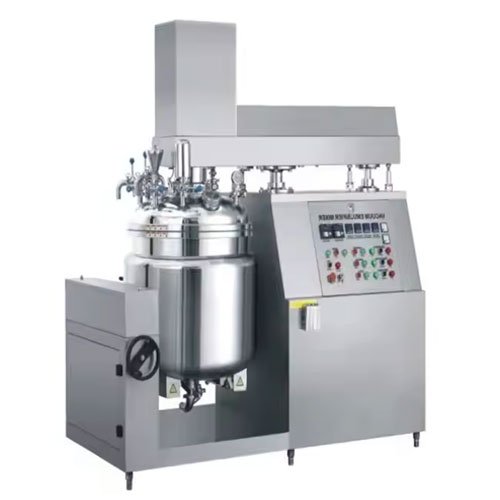Vacuum Emulsifier Homogenizer
A Vacuum Emulsifier Homogenizer is a specialized processing system designed to create fine emulsions, dispersions, and homogeneous mixtures of immiscible phases (such as oil and water), especially in high-viscosity products. It combines vacuum mixing, high-shear homogenization, and precise temperature control in one integrated unit.
This machine is essential in industries where product consistency, stability, and smooth texture are critical, such as cosmetics, pharmaceuticals, food, and chemicals.
Working Principle of a Vacuum Emulsifier Homogenizer
The process typically consists of three main phases:
- Vacuum Mixing Phase
- High-Shear Emulsification Phase
- Homogenization & Cooling Phase
1. Vacuum Mixing
- Ingredients are loaded into water phase and oil phase pots separately.
- These are then preheated and mixed under atmospheric conditions.
- Transferred into the main emulsifying tank, where a vacuum pump evacuates the air.
- This reduces oxidation.
- Prevents foaming.
- Improves shelf life and product texture.
2. High-Shear Emulsification
- The high-shear homogenizer rotates at speeds up to 3,000–10,000 RPM.
- It consists of a stator and rotor assembly that creates intense mechanical shearing.
- Oil and water phases are forced through narrow gaps at high speed.
- The phases are broken into micron or nano-sized droplets (depending on configuration).
3. Cooling and Final Homogenization
- The product is continuously agitated by a scraper agitator (which rotates and lifts material from the wall).
- A heating/cooling jacket regulates temperature using steam, hot water, or chilled water.
- After emulsification, the vacuum system is turned off.
- The product is discharged directly to packaging using vacuum pressure or a bottom valve.
Key Components of a Vacuum Emulsifier Homogenizer |
| Component | Description |
| Main Emulsifying Pot | The core chamber where final product is processed. Made of SUS316L stainless steel, with jacketed heating/cooling and vacuum sealing. |
| Water Phase Pot | Used to dissolve and preheat water-soluble ingredients. |
| Oil Phase Pot | Used to melt and mix oil-based materials. |
| High-Shear Homogenizer | Located at the bottom or inline; includes a rotor-stator design. Creates shear forces (up to 25 m/s tip speed) for fine emulsification. |
| Scraper Mixer (Agitator) | Low-speed side scraper agitator (10–60 rpm) prevents sticking and ensures full mixing. May include dual-direction rotation and Teflon blades. |
| Vacuum Pump | Evacuates the air from the mixing pot to prevent oxidation and eliminate air bubbles. Helps during product discharge. |
| Heating & Cooling Jacket | Thermally controlled chamber that uses steam or hot/chilled water to maintain optimal process temperature (usually 30–150°C). |
| Control System (PLC/HMI) | User interface for managing vacuum pressure, temperature, mixing speed, process timing, batch reports, alarms. |
| Hydraulic Lid Lifter | Automates the opening and closing of the emulsifying pot for cleaning and ingredient loading. |
| Discharge Valve/System | Bottom discharge by valve or vacuum discharge system for hygienic output. |
Types of Vacuum Emulsifier Homogenizers |
| Type | Description |
| Top-mounted Homogenizer | Traditional design with homogenizer at top of the tank. Common but harder to clean. |
| Bottom Homogenizer | Homogenizing unit is installed at the bottom of the tank. Offers better energy transfer and cleaning access. |
| Inline Homogenizer | A separate high-shear homogenizer connected in a loop with recirculation. Suitable for large-scale production. |
| Pilot-scale Units | Small versions for lab testing and R&D before scaling up. Typically 5L to 50L in size. |
Applications of Vacuum Emulsifier Homogenizer
Cosmetics Industry
- Face creams, body lotions, serums, gels, ointments
- Precise control over viscosity, pH, and texture
- Ensures stable emulsions that won’t separate over time
Pharmaceutical Industry
- Ointments, gels, transdermal creams, topical formulations
- Critical for sterility, particle size reduction, and active ingredient dispersion
Food Industry
- Mayonnaise, sauces, dressings, spreads, dairy products
- Prevents phase separation and increases shelf stability
- Used under food-grade compliance standards (GMP, HACCP)
Chemical Industry
- Paints, coatings, lubricants, resins, waxes
- Consistent color distribution, particle dispersion, and product integrity
Benefits of Using Vacuum Emulsifier Homogenizer
- Improved product stability due to fine droplet size
- No air bubbles, which increases shelf life and reduces oxidation
- High efficiency and faster production cycles
- CIP (Clean-in-Place) and SIP (Sterilize-in-Place) compatible
- Scalable design (from lab units to 5000L+ production units)
- Supports GMP and FDA compliance in pharma and cosmetics









